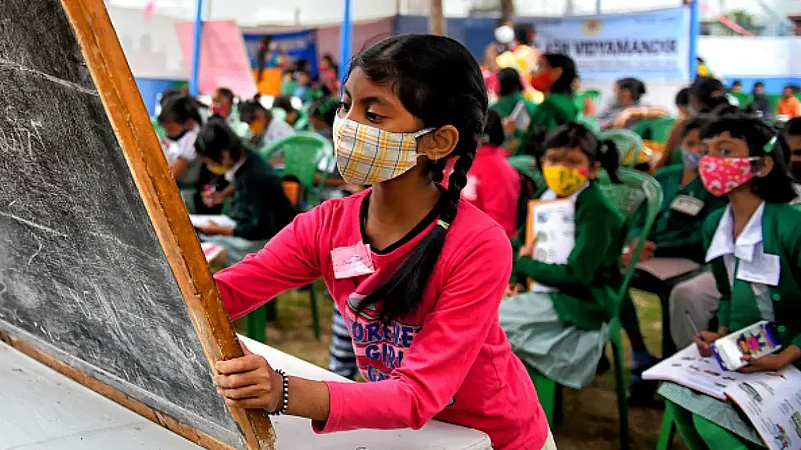From independence till now, we’ve come a long way in bridging the gender gap in education. In terms of the ratio in primary (classes I-V) school enrolment, there are now 1.02 girls for every boy, from 0.41 girls in 1950-51. In upper primary (classes VI-VIII), there are 1.01 girls per boy. The literacy rate for females has gone from 8.9 per cent at the time of the first census in 1951 to 65.8 per cent in 2018. According to the World Economic Forum’s Global Gender Gap Index 2022, India ranked first in enrolment in primary education.
While these numbers denote the progress we’ve made, the question that besets us now, as we enter our 76th year of independence and prepare for our centenary, is: have we done enough? Was bridging the gap between the number of boys and girls who complete primary and even secondary education our goalpost? Or, have we taken our starting point to be the end goal?
Advertisement
Gender parity in enrolment and school completion is an achievement that mustn’t be negated. It is in fact a prerequisite to building a society that is equitable and equal, where people of all gender identities get access to opportunities and can realise their full potential. Gender parity is not, however, the only factor that shall lead to gender equality.
Ensuring that children of all genders go to school is not an assurance that they are treated equally at school, or that they get equal access to academic and non-academic opportunities in school. Nor is it indicative of any shift in the existing mindset that considers gender identity a determinant of one’s role in the family, society, or economy.
Advertisement
The recently released Karnataka position paper on gender education reveals some startling, albeit not surprising, facts. In a survey conducted among teachers, parents, and students to understand their perceptions and attitudes regarding gender in the education space, these were some findings- most parents feel that nurturing and looking after the children are basic responsibilities of women. Most parents also believe that women tolerate violence for the good of the family and pointed to symbols of sacrifice and compassion. Among parents, 34 per cent feel that the behaviour and sartorial style of girls is the main cause of sexual abuse. Around 40 per cent of teachers also shared that they assign tasks related to decoration to girls and tangible physical tasks to boys.
There have been some interventions -- like gender awareness sessions for students in government schools in Haryana -- that have shown to lead to a shift in mindset and attitudes. While such interventions have shown positive results, they largely operate distinctly in the wider school ecosystem. Gender equality lessons and awareness sessions are certainly helpful but need to be supplemented by gender-responsive interventions in other processes and practices in school. To address a value as deeply entrenched as gender inequality, systemic shifts are needed. Changes at multiple levels including practices and processes that govern the everyday school experience of children must be targeted.
Advertisement
Common classroom habits like punishing boys more severely or making girls do more classroom chores, perpetuating stereotypes like boys are better at STEM (Science, Technology, Engineering & Mathematics) subjects while girls are inclined towards art or languages, or conveying subtle messaging on gender roles, such as men must take complete financial responsibility of their family while women must give primacy to taking care of their children and family, embed gender-unequal values in children that make it difficult for them to even imagine a gender-equal world.
Creating gender-equal schools would entail all its stakeholders to be gender responsive and address deep-rooted stereotypes. What this means for school leaders and educators is to question gender biases they may have internalised, and consciously create classroom and school spaces conducive to dialogue and discussion. For example, there is a prevalence of men as breadwinners and decision-makers and women are nurturers in most textbooks. On part of curriculum designers, it would require reviewing textbook content for gender biases, the perpetuation of stereotypes, and addressing the same. Gender-responsive teaching would acknowledge the existence of such biases in the textbook and highlight real-life examples that falsify these stereotypes, with the overarching objective being to nurture children who are not constrained to take up professional and personal roles in the future because of their gender.
Advertisement
In order to effect any substantive change, we must look at advancing gender equality both in and through education. The former may be indicated by gender parity in enrolment, school completion, representation of gender diversity, and equal opportunity for children of all genders to be empowered by education. Gender equality through education warrants a bigger endeavour, one that makes it an underlying mission of education to address gender inequality in the wider society and country. It views education as a powerful tool that can shift attitudes and mindsets that lead to gender-based discrimination and violence.
Aiming at a shift in mindset requires working with various stakeholders in the education system ranging from teachers, principals, parents, non-teaching staff, members of the community, and government and non-government organisations. Identifying what, where, and how gender-unequal attitudes and behaviour play out in a school environment and taking measures to address them is what we must prepare school leaders for. Building teacher capacity to facilitate classrooms where biases are identified, acknowledged, and questioned is as important. Such multi-stakeholder collaboration requires a strong commitment on part of those in authority- policymakers, education departments, and school management being the primary decision-makers.
Advertisement
That education is a means to a better life for individuals and a better society for all is often reiterated. As we celebrate 75 years of sovereign rule and over 72 years since we gave ourselves a Constitutional Right to Equality, it is time we reflect on whether we are doing enough to ensure that education enables gender equality.




















